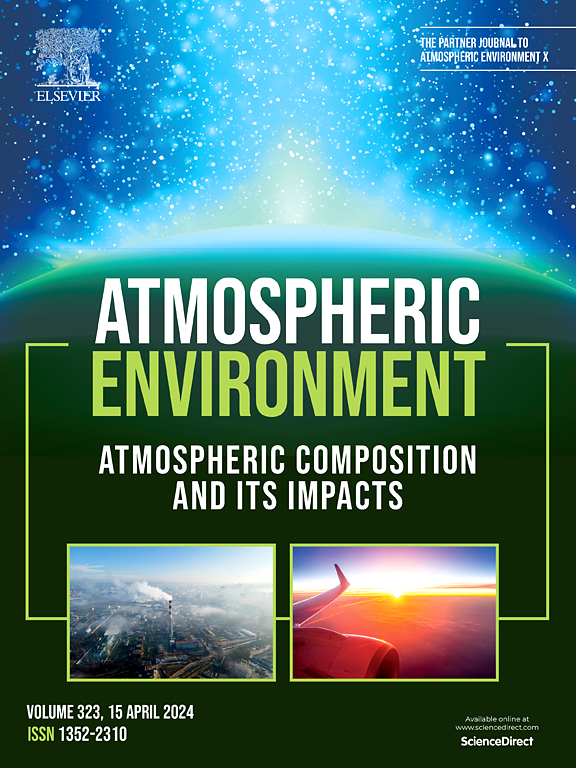Change in monoterpene concentrations during winter-to-summer transition period and impact of COVID-19 lockdown at an urban site in India
IF 4.2
2区 环境科学与生态学
Q2 ENVIRONMENTAL SCIENCES
引用次数: 0
Abstract
The significance of terpenoid emissions from traffic-related and biogenic sources in urban areas of the developing world is largely unknown, mainly due to the lack of measurements. This study is based on well time-resolved continuous measurements of ambient monoterpene concentration at an urban site in western India during January–May 2020, coinciding with the winter-to-summer and COVID-19 pre-lockdown to lockdown transitions. Despite large day-to-day variations of α-pinene (7–76 ppt) and β-pinene (6–55 ppt) their levels in winter were slightly higher than in summer. The trends in monoterpenes concentrations do not directly reflect the impact of enhanced biogenic contributions in summer due to counterbalancing effects of increased rates of oxidation and dilution. However, the increase of ∑α+β-pinene/∑BTEX ratios from 5 to 13 in winter to 61–87 ppt ppb−1 in summer highlights the impact of increased biogenic contributions at higher temperatures. The very high ∑α+β-pinene/∑BTEX ratios during the strict COVID-19 lockdown phases than the pre-lockdown period could be additionally attributed to the reductions of anthropogenic emissions. The estimated relative daytime biogenic contributions to α-pinene increased from 66 ± 10% in January to 88 ± 13% in May, while that of β-pinene from 56 ± 8% to 70 ± 19%. Overall, depending on the season, the complex interplay between the variability in anthropogenic activities, biogenic emissions, and photochemical/meteorological factors controls the ambient air variability of monoterpenes. The study provides insights into seasonal changes in anthropogenic and biogenic contributions of atmospheric monoterpenes. The knowledge of monoterpene sources is critical to assess secondary organic aerosol (SOA) formation, contributing to regional climate change.

冬夏过渡期间单萜烯浓度的变化以及2019冠状病毒病封锁对印度某城市的影响
发展中国家城市地区与交通有关的和生物源的萜类化合物排放的重要性在很大程度上是未知的,这主要是由于缺乏测量。本研究基于2020年1月至5月期间印度西部一个城市地点的环境单萜烯浓度的时间分辨率良好的连续测量,恰逢冬季到夏季和COVID-19从封锁前到封锁的过渡。尽管α-蒎烯(7-76 ppt)和β-蒎烯(6-55 ppt)的日变化较大,但冬季的α-蒎烯含量略高于夏季。单萜烯浓度的趋势并不能直接反映夏季由于氧化和稀释率增加的平衡作用而增强的生物源贡献的影响。然而,∑α+β-蒎烯/∑BTEX比值从冬季的5 ~ 13增加到夏季的61 ~ 87 ppb−1,凸显了高温下生物源贡献增加的影响。在严格封城期间,∑α+β-蒎烯/∑BTEX比值高于封城前,这可能是人为排放减少的另一个原因。α-蒎烯的相对生物源贡献率从1月份的66±10%增加到5月份的88±13%,β-蒎烯的相对生物源贡献率从56±8%增加到70±19%。总体而言,根据季节的不同,人为活动、生物源排放和光化学/气象因子的变异性之间的复杂相互作用控制着单萜烯的环境空气变异性。该研究提供了对大气中单萜烯的人为和生物贡献的季节变化的见解。单萜烯来源的知识对于评估二次有机气溶胶(SOA)的形成至关重要,这有助于区域气候变化。
本文章由计算机程序翻译,如有差异,请以英文原文为准。
求助全文
约1分钟内获得全文
求助全文
来源期刊

Atmospheric Environment
环境科学-环境科学
CiteScore
9.40
自引率
8.00%
发文量
458
审稿时长
53 days
期刊介绍:
Atmospheric Environment has an open access mirror journal Atmospheric Environment: X, sharing the same aims and scope, editorial team, submission system and rigorous peer review.
Atmospheric Environment is the international journal for scientists in different disciplines related to atmospheric composition and its impacts. The journal publishes scientific articles with atmospheric relevance of emissions and depositions of gaseous and particulate compounds, chemical processes and physical effects in the atmosphere, as well as impacts of the changing atmospheric composition on human health, air quality, climate change, and ecosystems.
 求助内容:
求助内容: 应助结果提醒方式:
应助结果提醒方式:


